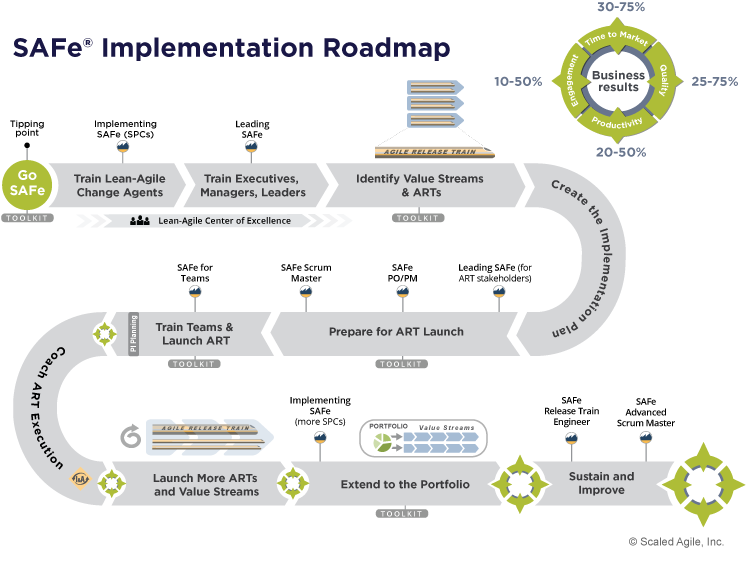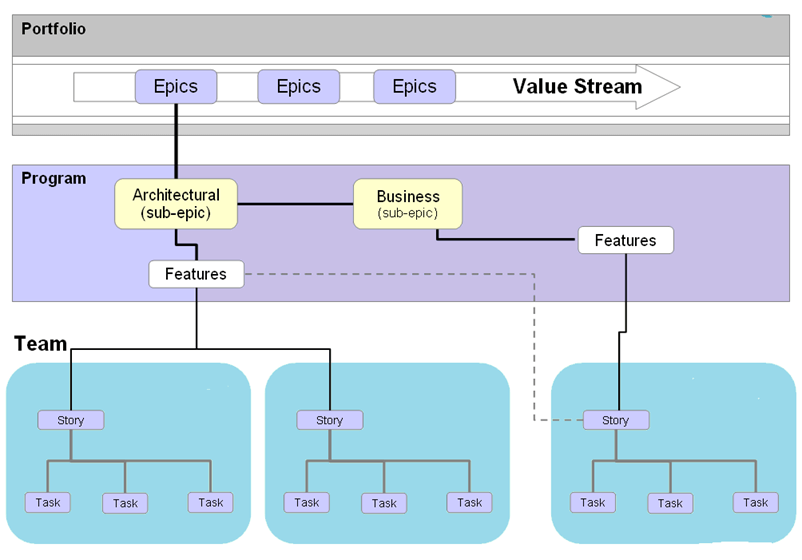Probably you’ve heard about what is SAFe in Agile but don’t know what it is and where to start.
Maybe you’ve just set your first steps in agile development or maybe you’ve run a pilot with a single team and want to leverage the benefits to more teams. Maybe you already have several teams working according to agile principles and you’ve run into some barriers that are holding you back from getting all the benefits. Or maybe you’ve been working in an agile manner with your team for several years and now want to adopt agile practices across your entire enterprise.
Whatever your situation is, you wonder whether it’s worth investing in one of Scaled Agile Frameworks to get your organization to the next level.
Since its arrival in the world market, there have been comparisons between the SAFe and other agile frameworks.
However, many industry experts have come out and pointed possible flaws in the Scaled Agile Framework. For instance, Ron Jeffries has expressed reservation over SAFe’s approach to resolve inter-team dependencies by holding a multi-team meeting comprising of over 250 people. Ken Schwaber has mentioned that SAFe does not adhere to the Agile Manifesto values (especially the first tenet – Individual and Interactions over Processes and Tool) as it is highly process-centric.
That’s where this article comes in! Here is an extensive overview of SAFe and its benefits, principles, and more aspects.
What is SAFe in Agile?
The Scaled Agile Framework (SAFe) is a set of organization and workflow patterns for implementing agile practices at an enterprise scale. The framework is a body of knowledge that includes structured guidance on roles and responsibilities, how to plan and manage the work, and values to uphold.
The SAFe framework was introduced in 2011. It was originally called the “Agile Enterprise Big Picture” by software-industry veteran Dean Leffingwell, who published the bestselling book Agile Software Requirements. The Big Picture described how to leverage existing agile frameworks such as Lean, Kanban, Scrum, and XP—and apply them at the Team, Program, and Portfolio. Today, SAFe’s entire catalog of knowledge and success patterns is all available for free, and it has become one of the most popular agile frameworks.
SAFe promotes alignment, collaboration, and delivery across large numbers of agile teams. It was formed around three primary bodies of knowledge: agile software development, lean product development, and systems thinking.
As businesses grow in size, SAFe provides a structured approach for scaling agile. There are four configurations in SAFe to accommodate various levels of scale: Essential SAFe, Large Solution SAFe, Portfolio SAFe, and Full SAFe.
The Scaled Agile Framework encompasses a set of principles, processes, and best practices that helps larger organizations adopt agile methodologies, such as Lean, Kanban, and Scrum, to develop and deliver high-quality products and services faster. SAFe is particularly well-suited to complex projects that involve multiple large teams at the project, program, and portfolio levels.
SAFe provides larger organizations with a way to leverage the benefits of Scrum and Kanban in a more scalable way. It enables larger organizations to manage projects with a higher degree of agility, offering a way for stakeholders across multiple groups to get feedback faster. This accelerated feedback loop leads to higher engagement levels, increased productivity and job satisfaction, and improved work quality.
SAFe Core Principles
The Scaled Agile Framework is built on nine core principles, taken from existing agile and lean principles. They are:
- Take an economic view (e.g., understand financial implications of delays, operating within small budgets, understanding economic trade-offs) to give the team optimal lead time while providing the best product development flow.
- Use the framework to implement systems thinking into three key areas: the solution (e.g., the deliverable product), value streams, and the enterprise building the system.
- Assume market and technical variability, thereby preserving options and encouraging innovation.
- Build incrementally using fast, integrated learning cycles and milestones, incorporate customer feedback, and reduce risks.
- Base your project’s milestones on objective estimation and the evaluation of actual working systems.
- Visualize and limit the quantity of work in progress (WIP), reduce batch sizes, and manage queue lengths to create a continuous flow. Limit the amount of overlapping work and the complexity of each item.
- Apply cadence (timing) and synchronize with cross-domain planning. This principle fosters collaboration, reduces complexity, enforces quality, and helps the team react better to uncertainty
- Unlock the intrinsic motivation and unleash the potential of knowledge workers by having leaders behave more like coaches, rather than as command-and-control bosses
Decentralize the decision-making process, giving teams more autonomy. This freedom, in turn, helps the teams become more agile and effective by making informed choices.

How does SAFe Work?
Organizations that are ready to implement SAFe usually have executive-level sponsorship, a strong purpose for change, and a foundation in Scrum.
A SAFe implementation roadmap should contain some detailed steps on how to get started and set up the organization for widespread adoption across portfolios.
The 12 steps for implementing SAFe include:
- Reaching the tipping point
- Train lean-agile change agents
- Train executives, managers, and leaders
- Create a lean-agile center of excellence
- Identify value streams and ARTs (Agile Release Trains)
- Create the implementation plan
- Prepare for ART launch
- Train teams and launch the ART
- Coach the ART execution
- Launch more ARTs and value streams
- Extend to the portfolio
- Sustain and improve

What are the Strengths and Weaknesses of SAFe?
SAFe offers a lot of advantages, including:
- Helps cross-functional teams collaborate more efficiently.
- Enables organizations to gain greater transparency, allowing stakeholders in multiple groups to acquire feedback faster.
- Aligns the project’s aspects with the organization’s broader business goals.
- Helps larger businesses to leverage Scrum and Kanban benefits in a more scalable way.
- Drives a faster time to market.
In the interests of full disclosure, SAFe isn’t perfect. Its weaknesses include:
- Since it requires significant process definition and up-front planning, some don’t consider SAFe a purely agile framework.
- It takes more of a top-down approach as opposed to a team-based approach.
- SAFe’s emphasis on the big picture often results in longer planning cycles more fixed roles in development cycles.
Should You Use the Scaled Agile Framework?
SAFe is most popular among enterprise organizations as many of its facets focus on eliminating the common challenges teams face when scaling agile.
It is a simple and lightweight framework, yet it is able to handle the needs of large value streams and complex system development. Benefits when implementing the SAFe agile framework include:
- Productivity increased by 20-50%
- Quality increased more than 50%
- Time to Market is faster than 30-75%
- Increased employee engagement and job satisfaction.
If your company is just beginning to transition to agile, SAFe might be a viable option to bridge that gap because of its more prescriptive approach than, say, Disciplined Agile (DA), which offers more flexibility and customization but also requires an organization to fully understand the agile philosophy already.
It is worth noting, however, that SAFe’s top-down approach to decision making and project management can undermine some of the core agile principles—such as collective ownership, adaptiveness, and less fixed roles—that might have attracted your team to agile in the first place.
The below image explains how the agile process works. Epics are a large body of work, which is further broken down into a number of smaller stories or sub-epics. These sub-epics are allocated to the team as a story. Each team then works on these stories or software features accordingly.

Ensuring a Successful Scaled Agile Framework With Nearshore Outsourcing
Considering SAFe’s popularity, team leaders should be well-versed in implementing and using the framework. Anyway, they often don’t have sufficient knowledge or face enormous resistance in their organizations when starting their digital journey. That’s why we are here!
For companies based in the US, implementing Agile and SAFe leveraged by a Nearshore strategy is a unique way because it includes more benefits than any other option available. So choosing the right digital transformation and agile partner is key. Technology and expertise are essential to successful projects.
We at Ascend would love to help your insurance company with your digital transformation through Nearshore outsourcing and Agile Software Development to achieve your business objectives.
Our competitive advantage is built with 20+ years of experience in the insurance industry, a reliable talent pool of skilled IT professionals and agile delivery teams, cost-effective solutions according to your needs, and multiple facets of services like Legacy Systems Modernization and Maintenance, Quality Assurance and Software Testing, etc.
